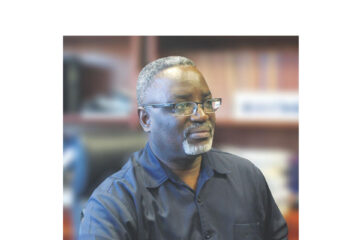Josef Kefas Sheehama
The President of Namibia, Her Excellency Dr. Netumbo Nandi-Ndaitwah, has my sincere gratitude for the excellent accountability report she delivered during her first ninety days in office. Prior to Vision 2030, Namibia launched its medium-term plan, the Sixth National Development Plan (NDP6). Therefore, Namibia’s degree of industrialisation is greatly influenced by how well or poorly this plan is implemented.
The First Hundred Days of Her Excellency Dr. Netumbo Nandi-Ndaitwah’s presidential administration was characterised by severe scrutiny, particularly when it came to cabinet resignations and emotive issues involving her cabinet members. Namibians express concerns about the administration’s cohesion and efficacy during a time of transition. Despite these challenges, the president and cabinet demonstrated their capacity to successfully manage the difficulties, express a clear vision, and lead in the face of adversity. The president underscored the progress made in delivering services to Namibians, as well as her leadership goal of eliminating corruption through governance reform. In an attempt to better coordinate trade, investment, and diplomatic endeavours, the president made the audacious decision to merge the Ministry of International Relations and Trade with the Namibia Investment Promotion and Development Board (NIPDB). It’s also commendable that the president is pushing for 24-hour border operations, modernising customs infrastructure, and extending trade corridors, all of which benefit the neighbouring countries’ businesses. These efforts are not merely symbolic; they tackle the actual obstacles that, among other things, hinder trade and raise costs for companies.
As Namibia moves closer to achieving the objectives of Vision 2030, the finish line of the National Development Plans (NDP1-6) signals the start of a new journey. When Her Excellency Dr. Netumbo Nandi-Ndaitwah unveiled the Sixth National Development Plan (NDP6), this adventure officially began. NDP 6 calls for a reform of the public and commercial sectors that fully addresses all facets of the current poor implementation attitude while fostering collective accountability, even though there hasn’t been much progress in either of the HPPs or NDPs 1–5. Considering NDP6 presents a long-term vision and strategic framework for Namibia’s growth, its launch could have a significant economic impact. If implemented correctly, it has the potential to boost economic growth, create jobs, reduce poverty, and raise living standards, all of which are necessary to move Namibia toward its goal of becoming an industrialised country by 2030. Namibia’s sixth National Development Plan (NDP6), covering the years 2025-2030, is based on four strategic pillars aimed at transforming the country through sustainable economic growth, human development, environmental sustainability, and effective governance, with each pillar having significant implications for the country’s emerging technology and digital sectors.
NDP6’s success depends on strong leadership, good execution, and cross-sector collaboration. It is now critical to track NDP6’s development, assess its effects, and provide ongoing feedback to ensure that NDP6, particularly V2030, meets its objectives. Policymakers must address the underlying constraints that hinder the full achievement of development goals and targets and negatively impact service delivery if Namibia wants to improve its Human Development Index from 0.610 to 0.695 and boost its human capital productivity from 0.45 to 0.50. This is not an easy task, and failing to do so will make it impossible to achieve V2030. Therefore, I urge leaders to create comprehensive action plans with explicit resource allocations and advocate for close cooperation between the government and development partners in order to optimise resource usage and prevent duplication of effort.
Furthermore, although FDI might boost economic growth in specific circumstances, it is not a surefire means to achieve wealth. In light of this, Namibia must figure out how to implement the Sixth National Development Plan (NDP6), which calls for roughly N$505 billion. The World Bank’s decision to reclassify Namibia from an upper-middle-income to a lower-middle-income nation should not be used as an excuse to obtain cheaper financing, concessional loans, development grants, or preferential trade agreements because grants cannot be used to expand an economy. Downgrading is not an option because it indicates a structural deterioration of the economy and poses serious threats to Namibia’s long-term goal of becoming an industrialised country. Therefore, in order to preserve economic stability and guarantee long-term sustainability, Namibia should place a high priority on fiscal discipline and refrain from additional rises in the national debt.
Moreover, with real GDP growth rates of 2.7% in 2021 and 4.6% in 2022. Notwithstanding the growth rate for 2023 being previously revised downwards to 4.2% and 3.7% in 2023 and 2024, respectively. In the first quarter of 2025, the economy grew 2.7%, which was slower than the 4.8% growth observed during the same time in 2024. By the end of March 2025, the government owed N$166.7 billion, an increase of 8.3% from the previous year. Thus, the country’s debt today stands at 66.3% of GDP, exceeding the SADC-targeted regional standard of 60%. In 2023, Namibia’s unemployment rate increased to 36.9%, according to new figures from the Namibia Statistics Agency (NSA). To increase the economy’s size and address the issues of poverty, inequality, and unemployment, new businesses in the mining, agricultural, and manufacturing sectors as well as significant investments in infrastructure and construction must be made rapidly. Namibia’s trade still favours imports, making it an importing country. This can only be resolved by increasing investment in value-added production, diversifying the economy, reducing the export of raw materials, finding new export markets through bilateral strategic approaches, and utilising already-existing regional trading blocs like BRICS. Given the estimated 3.5 million people, the country may suffer if economic growth lags behind population growth in the face of poverty and glaring inequality.
Going forward, Namibia should make investments in vital industries and minerals that will greatly help the country achieve its macroeconomic goals of increased economic dignity, job opportunities, productivity, high income, and a higher standard of living for its citizens. A coordinated and strategic approach is necessary for the successful implementation of the NDP6, integration with Agenda 2063, the SADC Vision 2050, the implementation of the free-carried 10% interest in mining, and the leveraging of the AfCFTA. Namibia can optimise its contribution to macroeconomic transformation and realise its own goal for 2030 and beyond by coordinating its national development priorities with these continental initiatives.
In conclusion, a multifaceted approach is required to successfully achieve Namibia’s industrialisation goals as stated in the National Development Plans (NDPs), of which NDP6 is the final one until 2030.
Furthermore, it is imperative to draw in foreign direct investment (FDI), promote local content, and strategically diversify the economy. Effective implementation and a solid public-private partnership are also crucial.




